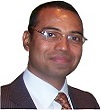
Nasir Jalal
Tianjin University, China
Title: DNA strand break associated bystander effect (DSB-ABE) linked to gene mutations
Biography
Biography: Nasir Jalal
Abstract
The goal of this project was to investigate whether radiation independent DNA damage, specifically a single induced DNA double strand break (DSB) can produce bystander signal, which is capable of inducing genomic instability in non-targeted cells. Previously uncharacterized E18 (modified TK6 cells) with a unique I-Sce1 insert in intron 2 of the thymidine kinase (TK1) gene were allowed to generate a bystander signal following electroporation of the rare cutting restriction enzyme I-Sce1 carried by a plasmid to induce DNA damage at the I-Sce1 site. Mutation assays were carried out to measure mutation fraction (MF) in directly targeted cells and using medium transfer, in non-targeted cells as a measure of bystander signal production. Transfection of the plasmid carrying I-Sce1 gene resulted in production of sufficient bystander signal into the medium to increase the bystander MF, when conditioned medium was applied from directly targeted to naïve E18 cells. The DSB-ABE exhibited temporal kinetics over a 10 hour duration. The relative direct and bystander MF increase due to the electroporation of three rare cutting restriction enzymes namely Not1 an 8 base cutter, Sfi1 a 13 base cutter (technically 8 because of the 5 non-specific bases in sequence) and I-Sce1 an 18 base cutter, showed that DSB-ABE does not show a dose-response. The bystander signal inhibition using superoxide dismutase (an enzyme that degrades reactive oxygen species) and PD 98059 (MEK1/2 inhibitor) indicated that the bystander signal activated the MAPK pathway in naïve cells. Higher levels of bystander mutation fraction were attempted through chemical inhibition of the three known enzymes of DNA repair (ATM, ATR and DNA PK) in directly targeted cells. Results reveal that inhibition of repair of I-Sce1 induced damage was not linked to bystander response. Further, sufficient bystander signal was produced by a presumably single I-Sce1 induced DNA break. The bystander signal produced, exhibited a dose-response in naïve cells and there was suggestion for the involvement of MAPK pathway.

